The automotive landscape is rich with competitive offerings, and two models that stand out in the compact SUV segment are the Ford Kuga and the Mazda CX-5. Both vehicles bring a unique blend of style, technology, and performance to the table, but how do they stack up against each other? Let's dive deep into the specifications, innovations, and overall driving experience of these two remarkable SUVs.
Ford Kuga vs Mazda CX-5 – Differences & prices compared
Both models have their strengths – but which one suits you more?
Compare performance, efficiency, price and space directly: Ford Kuga or Mazda CX-5?
Design and Comfort: Aesthetic Appeal
In terms of design, the Ford Kuga boasts a contemporary exterior with smooth lines and an athletic stance. Its dimensions stand at 4,604 mm in length, 1,882 mm in width, and a height of 1,675 mm, providing a spacious cabin for five passengers. The Mazda CX-5, measuring slightly longer at 4,575 mm, is equally appealing with its signature Kodo design language, characterized by flowing bodywork and an upscale interior.
The Kuga offers a trunk capacity of 412 liters, while the CX-5's trunk space is more generous at 522 liters, making it a better choice for families or those needing extra cargo space. Both vehicles come with five doors, allowing easy access to rear seats. Inside, the Kuga focuses on modern infotainment systems, while the CX-5 leans towards driver-centric ergonomics, emphasizing both style and functionality.
Powertrains: A Spectrum of Choices
When comparing engines, the Ford Kuga offers a variety of options including petrol, full hybrid, and plug-in hybrid variants. The petrol engines range from 150 to 243 HP, allowing consumers to choose based on their performance desires, while fuel consumption figures can be as low as 5.3 L/100km for the efficient models. The addition of a plug-in hybrid option gives the Kuga a range of approximately 69 km on electric power alone, highlighting its commitment to sustainability.
On the other hand, the Mazda CX-5 features petrol MHEV and diesel engines, with power outputs from 150 HP to 194 HP. The vehicle is known for its reliability and offers a balance of performance and efficiency, with fuel consumption figures averaging around 6.5 L/100km. Although not as varied as the Kuga, the CX-5 still provides sufficient options for those who prefer diesel engine alternatives.
Performance and Driving Experience
Acceleration figures reveal some interesting insights; the Kuga's quickest model can sprint from 0-100 km/h in just 7.3 seconds, while the CX-5 takes a bit longer, ranging between 9.2 to 10.7 seconds depending on the engine choice. This suggests that while the Kuga is designed for a more spirited drive, the CX-5 is engineered for a more stable and relaxed experience.
The Kuga also features various driving modes, enhancing its flexibility on different terrains, thanks to available all-wheel drive and front-wheel options. The CX-5, built on Mazda's Skyactiv technology, focuses on agility and response, assuring that drivers can enjoy winding roads without sacrificing comfort.
Technological Innovations: Advanced Features
In terms of technology, both the Ford Kuga and Mazda CX-5 come equipped with a suite of driver assistance features. The Kuga shines with Ford’s latest SYNC infotainment system, providing seamless smartphone integration and a user-friendly interface. This SUV's driving assistance capabilities also include adaptive cruise control and lane-keeping assist, making long journeys more relaxing.
The CX-5 counters with its advanced safety suite including Smart City Brake Support and its unique G-Vectoring Control, enhancing stability during cornering. The interior is outfitted with high-quality materials, a large touchscreen interface, and a sophisticated audio system, speaking to Mazda’s commitment to elevating the driving experience.
Conclusion: Which One Reigns Supreme?
Choosing between the Ford Kuga and the Mazda CX-5 ultimately depends on individual preferences. The Kuga offers modern powertrains and impressive technology, tailored for those seeking efficiency and excitement. In contrast, the CX-5 stands out with its stylish design, robust diesel options, and superior interior quality, prioritizing comfort and driver engagement.
In a competitive SUV market, both the Ford Kuga and Mazda CX-5 present compelling arguments, ensuring that potential buyers can choose a model that best aligns with their lifestyle and driving preferences.
Here’s where it gets real: The technical differences in detail
Costs and Efficiency:
When it comes to price and running costs, the biggest differences usually appear. This is often where you see which car fits your budget better in the long run.
Mazda CX-5 has a somewhat advantage in terms of price – it starts at 30000 £, while the Ford Kuga costs 34200 £. That’s a price difference of around 4242 £.
Fuel consumption also shows a difference: Ford Kuga manages with 2.80 L and is therefore clearly more efficient than the Mazda CX-5 with 7 L. The difference is about 4.20 L per 100 km.
Engine and Performance:
Under the bonnet, it becomes clear which model is tuned for sportiness and which one takes the lead when you hit the accelerator.
When it comes to engine power, the Ford Kuga has a decisively edge – offering 243 HP compared to 141 HP. That’s roughly 102 HP more horsepower.
In acceleration from 0 to 100 km/h, the Ford Kuga is convincingly quicker – completing the sprint in 7.30 s, while the Mazda CX-5 takes 10.50 s. That’s about 3.20 s faster.
In terms of top speed, the Ford Kuga performs minimal better – reaching 200 km/h, while the Mazda CX-5 tops out at 195 km/h. The difference is around 5 km/h.
There’s also a difference in torque: Ford Kuga pulls hardly perceptible stronger with 240 Nm compared to 238 Nm. That’s about 2 Nm difference.
Space and Everyday Use:
Cabin size, boot volume and payload all play a role in everyday practicality. Here, comfort and flexibility make the difference.
Both vehicles offer seating for 5 people.
In curb weight, Ford Kuga is minimal lighter – 1526 kg compared to 1629 kg. The difference is around 103 kg.
In terms of boot space, the Mazda CX-5 offers evident more room – 583 L compared to 412 L. That’s a difference of about 171 L.
In maximum load capacity, the Mazda CX-5 performs noticeable better – up to 2019 L, which is about 485 L more than the Ford Kuga.
Who comes out on top?
Overall, the Ford Kuga shows itself to be leaves the rival little chance and secures the title of DriveDuel Champion.
It convinces with the more balanced overall package and proves to be the more versatile choice for everyday use.
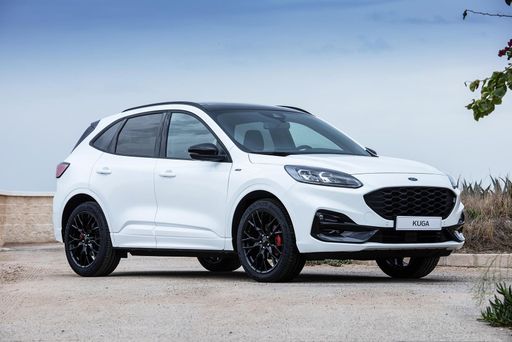 @ Ford Motor Company / Ford Media Center
@ Ford Motor Company / Ford Media Center
Ford Kuga
Ford Kuga
The Kuga is Ford’s adaptable family SUV that blends usable space with a surprisingly lively driving character, making daily commutes and weekend escapes equally enjoyable. With smart interior packaging, an easy-to-use infotainment setup and composed road manners, it’s a sensible choice for buyers who want a bit of fun without the fuss.
details @ Ford Motor Company / Ford Media Center
@ Ford Motor Company / Ford Media Center
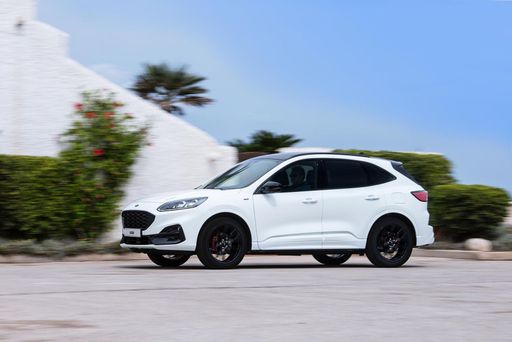 @ Ford Motor Company / Ford Media Center
@ Ford Motor Company / Ford Media Center
 @ Ford Motor Company / Ford Media Center
@ Ford Motor Company / Ford Media Center
Mazda CX-5
The Mazda CX-5 exemplifies the perfect blend of style and practicality, offering a sleek design that turns heads while providing ample space for passengers and luggage. Its refined interior boasts high-quality materials and a user-friendly interface, making every journey a comfortable experience. With its engaging driving dynamics, the CX-5 delivers both performance and efficiency, appealing to drivers who crave excitement and reliability.
details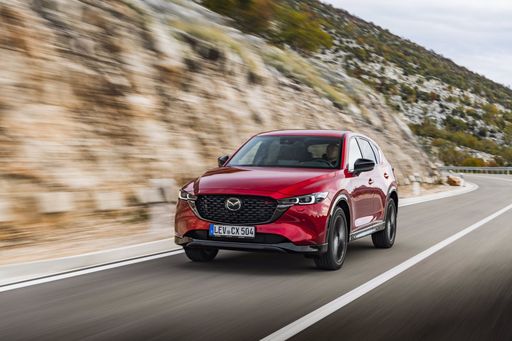 @ Mazda Motor Corporation
@ Mazda Motor Corporation
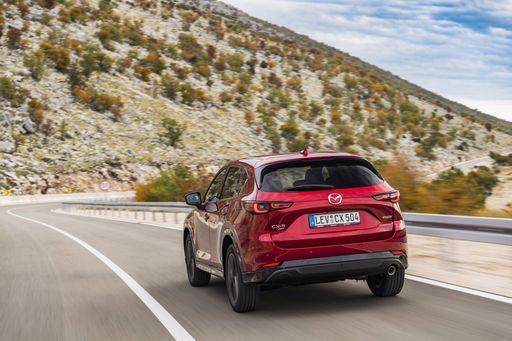 @ Mazda Motor Corporation
@ Mazda Motor Corporation
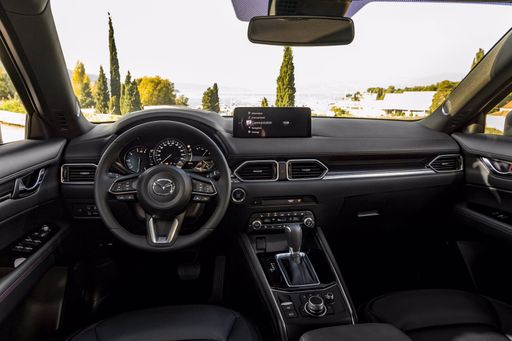 @ Mazda Motor Corporation
@ Mazda Motor Corporation
 @ Ford Motor Company / Ford Media Center
@ Ford Motor Company / Ford Media Center
|
 @ Mazda Motor Corporation
@ Mazda Motor Corporation
|
|
|
|
Costs and Consumption |
|
|---|---|
|
Price
34200 - 46300 £
|
Price
30000 £
|
|
Consumption L/100km
2.8 - 6.8 L
|
Consumption L/100km
7 L
|
|
Consumption kWh/100km
-
|
Consumption kWh/100km
-
|
|
Electric Range
68 km
|
Electric Range
-
|
|
Battery Capacity
1.1 - 14.4 kWh
|
Battery Capacity
-
|
|
co2
55 - 154 g/km
|
co2
157 g/km
|
|
Fuel tank capacity
42 - 54 L
|
Fuel tank capacity
56 L
|
Dimensions and Body |
|
|---|---|
|
Body Type
SUV
|
Body Type
SUV
|
|
Seats
5
|
Seats
5
|
|
Doors
5
|
Doors
5
|
|
Curb weight
1526 - 1859 kg
|
Curb weight
1629 kg
|
|
Trunk capacity
412 L
|
Trunk capacity
583 L
|
|
Length
4604 - 4645 mm
|
Length
4690 mm
|
|
Width
1882 mm
|
Width
1860 mm
|
|
Height
1673 - 1681 mm
|
Height
1695 mm
|
|
Max trunk capacity
1534 L
|
Max trunk capacity
2019 L
|
|
Payload
541 - 550 kg
|
Payload
-
|
Engine and Performance |
|
|---|---|
|
Engine Type
Petrol, Full Hybrid, Plugin Hybrid
|
Engine Type
Petrol MHEV
|
|
Transmission
Manuel, Automatic
|
Transmission
Automatic
|
|
Transmission Detail
Manual Gearbox, CVT, Automatic Gearbox
|
Transmission Detail
Automatic Gearbox
|
|
Drive Type
Front-Wheel Drive, All-Wheel Drive
|
Drive Type
Front-Wheel Drive
|
|
Power HP
150 - 243 HP
|
Power HP
141 HP
|
|
Acceleration 0-100km/h
7.3 - 9.9 s
|
Acceleration 0-100km/h
10.50 s
|
|
Max Speed
195 - 200 km/h
|
Max Speed
195 km/h
|
|
Torque
240 Nm
|
Torque
238 Nm
|
|
Number of Cylinders
3 - 4
|
Number of Cylinders
4
|
|
Power kW
111 - 178 kW
|
Power kW
104 kW
|
|
Engine capacity
1496 - 2488 cm3
|
Engine capacity
2488 cm3
|
General |
|
|---|---|
|
Model Year
2025
|
Model Year
2025
|
|
CO2 Efficiency Class
E, D, B
|
CO2 Efficiency Class
F
|
|
Brand
Ford
|
Brand
Mazda
|
What drivetrain options does the Ford Kuga have?
The Ford Kuga is available as Front-Wheel Drive or All-Wheel Drive.
The prices and data displayed are estimates based on German list prices and may vary by country. This information is not legally binding.
